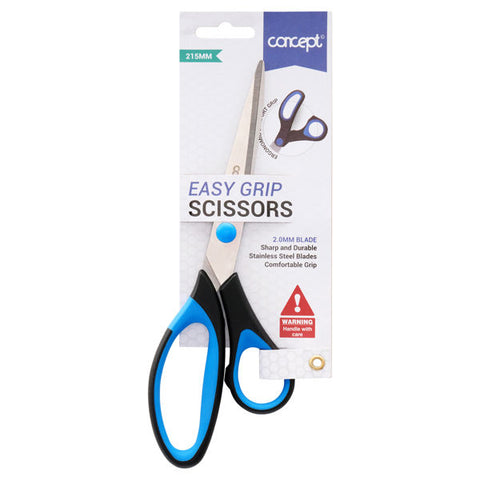
The Best Scissors for Office Professionals
Office scissors are something you’re likely to find in every desk drawer or stationery bag in an office. In the working world, they’re far from child’s play. In the hands of professionals, scissors play a role in helping teams stay organised and on track with their goals. From everyday tasks like opening packages to compiling presentations and organising documents, your choice of scissors can make all the difference. So which scissors are the best choice for busy office professionals?
What Are Office Scissors Used For?
- Trimming or cutting paper for documents, presentations, and craft projects.
- Cutting through packaging materials like tape and cardboard when unboxing supplies or deliveries.
- Engaging in creative tasks such as making mock-ups, prototypes, or decorative items for office events.
- Cutting labels and stickers to size for organising files, equipment, or storage areas.
- If there's a need for fabric use in the office, like for event decorations, costumes, or minor upholstery repairs.
- Trimming printed photos, graphics, or brochures for presentations or displays.
- Offices with kitchens might use scissors for cutting food packages, and herbs, or as a general kitchen tool.
- Occasionally, scissors might be used for emergency grooming needs, like trimming a frayed thread on clothing before meetings.
- For offices that engage in team-building or recreational activities involving arts and crafts.
- For minor repairs or DIY projects around the office space.
- Cutting and shaping promotional materials like flyers, banners, or handouts.
- Performing minor maintenance tasks like snipping zip ties, cutting wallpaper or lining shelves.
These tasks highlight the multi-functional nature of scissors in an office environment, making them an essential tool in various day-to-day operations.
Types of Office Scissors
Various types of scissors are used in an office environment, each designed for specific tasks or preferences. Here's a rundown of the common types of scissors you might find in a professional setting:
General-Purpose Scissors
These are the all-rounders of the scissor world. Usually about 6 to 8 inches long, they are designed for a variety of basic office tasks.
Uses: Ideal for cutting paper, opening packages, or trimming small items. They're the go-to for everyday office tasks.
Precision Scissors
Precision scissors have a finger tip and are designed for detailed cutting work.
Uses: Perfect for tasks that require accuracy, like cutting out shapes, trimming photos, or detailed craft work.
Kitchen Scissors
Durable and often multi-functional, these scissors are designed for various kitchen tasks.
Uses: Ideal for cutting food items, opening tough packaging, or even performing light culinary tasks like snipping herbs. They're handy in office kitchens for preparing snacks or meals.
Heavy-Duty Scissors
Built with stronger materials and often larger in size, these scissors can handle tougher materials.
Uses: Cutting through thicker paper, cardboard, fabric, or even thin plastic. Ideal for more demanding tasks that regular scissors can't handle.
Safety Scissors
These scissors have a rounded tip and are designed to be safer to use, reducing the risk of accidental injury.
Uses: Ideal for a setting where safety is a priority, like schools or workshops, or for tasks that don't require sharp tips.
Craft Scissors
Craft scissors come in various shapes and sizes, some with decorative edges for creative cutting.
Uses: Used for creating decorative patterns, scrapbooking, or other craft-related activities that require a creative touch.
How To Choose The Best Office Scissors
Choosing the best office scissors involves considering several factors to ensure they meet your specific needs, enhance efficiency and offer comfort during use. Here’s a guide to selecting the ideal pair of office scissors:
1.Purpose and Use
- Assess the primary tasks for which you need the scissors. Different tasks require different types of scissors, such as general-purpose, precision, or heavy-duty.
- If you have specialised needs like crafting or detailed cutting, look for scissors designed for those specific tasks.
2.Blade Quality
- Opt for high-quality stainless steel blades as they are durable, rust-resistant, and maintain sharpness longer.
- Consider the blade length appropriate for your tasks – longer blades for cutting through large sheets, shorter for precision work.
3.Handle Comfort and Design
- Ergonomically designed handles can significantly reduce hand fatigue, especially important if you use scissors frequently or for long periods.
- Look for handles that fit comfortably in your hand. Some scissors have cushioned handles for extra comfort.
4.Size and Weight
- Choose a size and weight that feels balanced and comfortable. Heavier scissors might be more durable but can be tiring to use over time.
- Consider the storage and portability requirements. Compact or folding scissors are great for on-the-go professionals.
5.Special Needs
- If you are left-handed, ensure the scissors are designed for left-hand use or are truly ambidextrous.
- For specific projects, like arts and crafts, consider scissors with specialised blades (e.g., zig-zag pattern) for decorative cuts.
6.Price vs. Quality
- Balance cost with quality. While higher-priced scissors often offer better quality and longevity, mid-range options can also provide good value.
- Consider the expected lifespan and how often you’ll use them to determine a reasonable budget.
By taking these factors into account, you can select a pair of office scissors that will become a reliable tool in your professional toolkit. Feel free to browse our range of office scissors to find the best cutting tools for your team.